Samaria Gorge Crete: Complete Guide to Europe's Longest Gorge
Discover everything you need to know about hiking this spectacular natural wonder - trail information, transportation logistics, preparation tips, and insider advice
Samaria Gorge: Crete's Iconic Natural Wonder
Carved over millennia by the Tarraios River through the heart of Crete's White Mountains, Samaria Gorge stands as one of Europe's most spectacular natural landmarks and the continent's longest gorge. This 16-kilometer journey from the Omalos Plateau to the Libyan Sea takes hikers through an extraordinary landscape of towering cliffs, ancient cypress forests, abandoned settlements, and diverse ecosystems. At its most dramatic point – the legendary "Iron Gates" – the gorge narrows to just 4 meters wide while soaring cliff walls rise 300 meters overhead. As Crete's premier hiking destination and a protected National Park, Samaria offers an unforgettable adventure that combines natural beauty, physical challenge, and cultural heritage. This comprehensive guide covers everything you need to know to successfully navigate and fully appreciate this iconic Cretan experience – from practical logistics and physical preparation to the gorge's unique flora, fauna, and historical significance.
Contents
- About Samaria Gorge
- Logistics & Planning
- Transportation & Access
- The Trail & Hiking Experience
- Key Highlights & Landmarks
- Physical Preparation & Requirements
- What to Bring
- Best Time to Hike
- Flora & Fauna
- Historical & Cultural Significance
- Park Regulations & Conservation
- Alternative Hikes & Options
- Nearby Accommodation
- Safety Information
- Frequently Asked Questions
- Car Rental for Your Crete Trip
About Samaria Gorge
Samaria Gorge (Φαράγγι Σαμαριάς in Greek) is a national park located in the White Mountains (Lefka Ori) of western Crete, the largest and most southerly of the Greek islands. As Europe's longest gorge at 16 kilometers, it ranks among the continent's most significant natural attractions and represents one of Crete's most visited sites.
Geographic Significance
The gorge was formed through millennia of erosion as the Tarraios River carved its way through the White Mountains toward the Libyan Sea. This natural process created a dramatic landscape with several distinct characteristics:
- Elevation Change: The hike begins at Xyloskalo at an altitude of 1,230 meters (4,040 feet) and descends to sea level at Agia Roumeli
- Variable Width: The gorge ranges from 150 meters wide at its broadest point to just 4 meters at the famous "Iron Gates" (Sideroportes)
- Towering Cliffs: Vertical walls rise as high as 500 meters in some sections
- Diverse Terrain: The path transitions from pine and cypress forests at higher elevations through rocky landscapes and riverbed sections
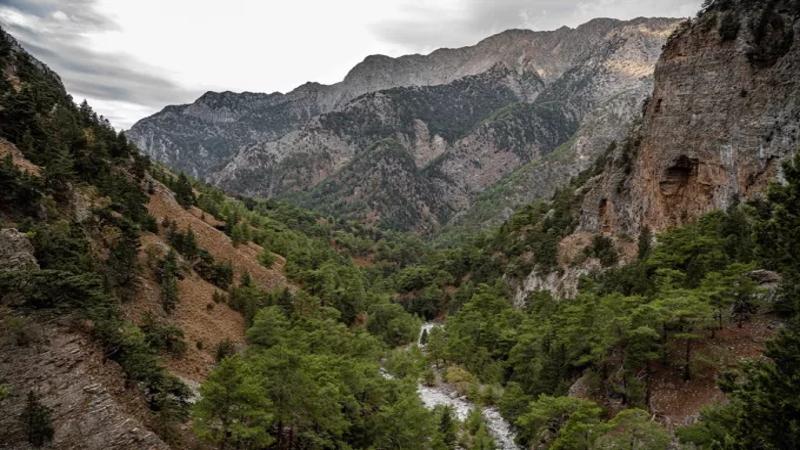
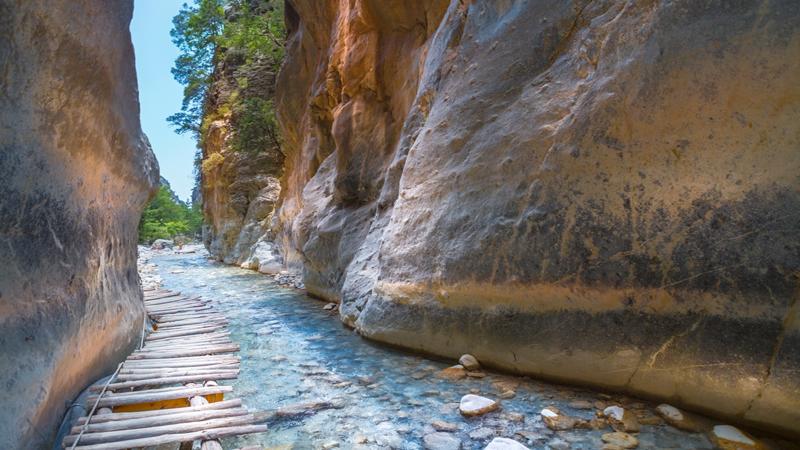
Protected Status
Since 1962, Samaria has been a designated National Park, and in 1981 it was recognized as a UNESCO Biosphere Reserve. This protected status serves multiple purposes:
- Conservation of unique ecosystems and biodiversity
- Preservation of endemic species, particularly the Cretan wild goat (kri-kri)
- Protection of historical and cultural elements, including abandoned settlements
- Controlled visitor access to prevent environmental degradation
The Abandoned Village of Samaria
Near the midpoint of the gorge lies the abandoned village of Samaria, from which the gorge takes its name. This settlement was continuously inhabited since ancient times until 1962, when it was evacuated to establish the National Park. The village contains:
- The 14th-century church of Osia Maria (from which the name "Samaria" derives)
- Restored stone houses demonstrating traditional mountain architecture
- Ancient cypress trees, including some estimated to be over 2,000 years old
- The remains of water mills and agricultural terraces
Today, the old village serves as a rest area for hikers and houses facilities for park rangers and emergency services.
Cultural and Historical Context
Beyond its natural splendor, Samaria holds deep cultural and historical significance for Crete:
- During various occupations of Crete (Ottoman, German), the gorge served as a refuge for resistance fighters
- Ancient Minoans likely used the gorge for religious ceremonies, with evidence of sacred sites
- The area contains archaeological remnants spanning multiple historical periods
- Traditional shepherding routes through the mountains incorporated the gorge path
- Local folklore and legends are associated with various locations throughout the gorge
The gorge represents both the natural resilience of the landscape and the enduring spirit of the Cretan people who have made these mountains their home for thousands of years.
Physical Preparation & Requirements
Hiking Samaria Gorge is a significant physical undertaking that requires proper preparation. While not technically difficult in terms of climbing skills, the length, terrain, and conditions present challenges that shouldn't be underestimated.
Fitness Requirements
To comfortably complete the gorge hike, you should:
- Be able to walk continuously for 5-7 hours on varied terrain
- Have sufficient leg strength for a long, sustained descent
- Possess reasonable balance for uneven surfaces and river crossings
- Have adequate cardiovascular endurance for the overall distance
- Be prepared for temperature variations and potential heat stress
Physical Challenges to Consider
- Knee Stress: The prolonged descent puts considerable strain on knees and quadriceps
- Ankle Stability: Rocky, uneven terrain requires good ankle strength and stability
- Balance: River crossings and narrow paths demand reasonable balance
- Heat Tolerance: Summer temperatures can exceed 35°C (95°F) in the lower gorge
- Endurance: The overall length (16km) requires sustained energy
Who Should Not Attempt the Hike
For safety reasons, the following individuals should consider alternative activities:
- People with severe knee, hip, or ankle problems
- Those with serious heart conditions or respiratory issues
- Individuals with severe mobility limitations
- Very young children (under 6-7 years) due to the distance and terrain
- Anyone with heat sensitivity issues in summer months
- Those who cannot walk 5+ hours even on flat terrain
Training & Preparation
If you have several weeks or months before your trip, consider this preparation:
- Cardio Conditioning: Regular walking or hiking, gradually increasing distance
- Downhill Training: Practice descending steep hills to condition knees and quads
- Strength Exercises: Focus on leg strength, particularly quadriceps and calves
- Balance Work: Simple balance exercises to improve stability on uneven terrain
- Breaking In Footwear: Ensure hiking shoes are well broken-in before the trip
Alternative Options
If the full gorge seems too challenging, consider these alternatives:
- "Lazy Way" (Reverse) Route: Take a morning boat to Agia Roumeli and hike up into the lower gorge as far as the Iron Gates (7km round trip), then return to the village
- Upper Gorge Only: Hike from Xyloskalo down to the abandoned village or first checkpoint and then return the same way (shorter but with uphill return)
- Small Gorges: Numerous smaller gorges throughout Crete offer similar scenery with less demanding trails
Children & Seniors
Special considerations for age groups:
- Children: Generally suitable for active children 8+ years; younger children may struggle with the distance
- Seniors: Many active seniors successfully complete the gorge; age itself is not a limitation, but rather fitness level
- Family Pacing: Allow extra time if hiking with children or seniors
- Heat Sensitivity: Both young children and seniors can be more vulnerable to heat effects
With proper preparation and realistic expectations, most reasonably fit individuals can complete and enjoy this remarkable hike. The key is honest self-assessment and appropriate planning.
What to Bring
Proper equipment and supplies are essential for a safe and comfortable Samaria Gorge experience. Pack thoughtfully but minimally, as you'll carry everything for the entire 16km hike.
Essential Equipment
- Footwear: Proper hiking shoes or boots with ankle support and good traction (the most important item)
- Backpack: Small to medium daypack (15-25 liters) to carry all supplies
- Water Containers: Capacity for at least 1.5-2 liters per person (more in hot weather)
- Sun Protection: Hat with brim, sunglasses, and high-SPF sunscreen
- Personal Identification: ID card or passport copy (required for entrance ticket)
- Cash: For entrance fee (€5), boat ticket if not pre-purchased, and purchases in Agia Roumeli
- Basic First Aid: Plasters/bandages, pain relievers, blister treatment, personal medications
Clothing Recommendations
Dress in layers and choose appropriate materials:
- Base Layer: Lightweight, moisture-wicking t-shirt (avoid cotton as it stays wet with sweat)
- Mid Layer: Light long-sleeve shirt or thin fleece (for morning start and shade protection)
- Outer Layer: Lightweight wind/rain jacket, especially in spring or fall
- Bottoms: Comfortable hiking pants or shorts (convertible pants are ideal)
- Socks: Moisture-wicking hiking socks (consider a spare pair)
- Swimwear: Optional for swimming in Agia Roumeli after the hike
Food & Water
There are no food vendors within the gorge:
- Water: Start with 1.5-2 liters minimum; refills available at springs within the gorge
- Energy-Dense Foods: Trail mix, nuts, dried fruits, energy bars
- Lunch: Sandwiches, wraps, or other portable meal options
- Snacks: Easily consumed items for quick energy during brief stops
- Electrolytes: Tablets or powder to add to water, especially in hot weather
While spring water is available at several points throughout the gorge, never rely solely on these sources as water flow can vary seasonally.
Optional But Useful Items
- Trekking Poles: Highly recommended to reduce strain on knees during the long descent
- Camera: For capturing the stunning scenery (with protective case)
- Swim Towel: Lightweight quick-dry towel for swimming at Agia Roumeli
- Binoculars: For wildlife viewing, especially kri-kri on distant slopes
- Guidebook/Map: While the trail is well-marked, these provide context and information
- Power Bank: For phone charging (useful for photos and emergencies)
- Water Filter/Purification: Backup option though spring water is generally safe

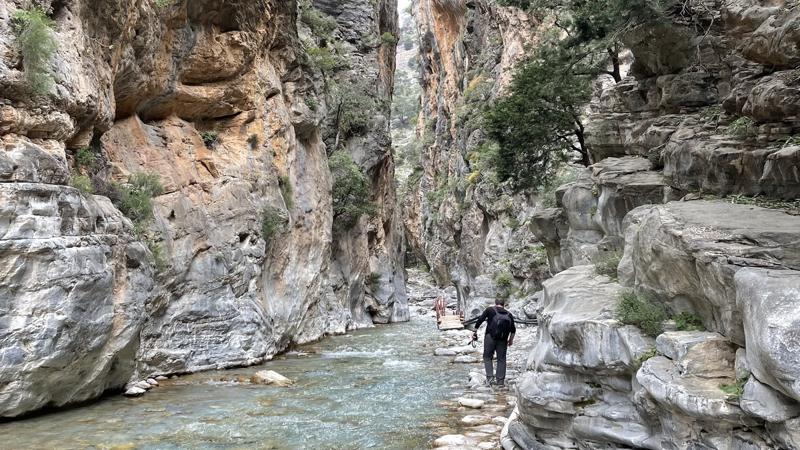
What Not to Bring
Avoid unnecessary weight and impractical items:
- Heavy photography equipment (tripods, multiple lenses)
- Excessive clothing changes
- Heavy food items or those requiring preparation
- Bulky guidebooks (bring digital versions or photocopies of relevant pages)
- Valuable items that could be damaged or lost
Remember that whatever you bring, you'll carry for the entire hike. Pack smart, focusing on essentials and multipurpose items to minimize weight while maximizing preparedness.
Best Time to Hike
Timing your Samaria Gorge hike can significantly impact your experience. Consider both seasonal factors and time of day when planning your visit.
Seasonal Considerations
Peak Tourist Season: Mid-June to early September
Best Balance of Conditions: May, early June, late September, early October
Hottest Period: July and August
Most Colorful (Flowers): Late April to early June
Spring (May to early June)
- Advantages:
- Moderate temperatures (18-25°C / 64-77°F)
- Vibrant wildflowers throughout the gorge
- Higher water levels create more dramatic river scenes
- Fewer visitors compared to summer months
- Lush vegetation and more active wildlife
- Considerations:
- Potentially higher water at river crossings
- Occasional rain showers possible
- Cooler mornings at the high-altitude starting point
- Sea temperature at Agia Roumeli may be cooler for swimming
Summer (Late June to August)
- Advantages:
- Consistent weather with virtually no rain
- Longer daylight hours for hiking
- Warmest sea temperatures at Agia Roumeli
- All facilities and services fully operational
- Reliable boat and bus connections
- Considerations:
- Very hot temperatures, especially in the lower gorge (can exceed 35°C / 95°F)
- Most crowded period with 1000+ hikers daily
- Limited shade in the lower sections
- Higher prices for accommodation and services
- Need for advance booking for nearby accommodations
Autumn (September to October)
- Advantages:
- Pleasant temperatures (20-28°C / 68-82°F)
- Fewer visitors, especially after mid-September
- Sea remains warm for swimming
- Beautiful afternoon light for photography
- More peaceful atmosphere on the trail
- Considerations:
- Shorter daylight hours as October progresses
- Potential for occasional autumn storms
- Reduced services in late October
- Drier landscape with less flowing water
Time of Day Considerations
The timing of your hike during the day is equally important:
- Early Start Advantage: Begin as early as possible (ideally between 7:00-8:00 AM) to:
- Hike during cooler morning hours
- Beat the crowds from organized tour buses
- Ensure sufficient time to complete the hike comfortably
- Have flexibility for rest breaks
- Arrive at Agia Roumeli with time to relax before the ferry
- Key Timing Points:
- First bus arrival at Xyloskalo: Usually around 7:30-8:00 AM
- Busiest entry period: 8:30-10:30 AM
- Midday heat peak: 12:00-3:00 PM
- Final entry time: 2:00 PM (not recommended as too late)
- Typical ferry departure from Agia Roumeli: 5:30 PM
Weather Considerations
Weather patterns can significantly impact your hike:
- Rain: The gorge may close during or after heavy rainfall due to flash flood risk
- Heat: July and August temperatures in the lower gorge often exceed 35°C (95°F)
- Wind: Strong winds are rare within the gorge but may affect boat departures
- Morning Chill: Early mornings at Xyloskalo (1,250m elevation) can be quite cool, even in summer
Always check weather forecasts before your hike and be prepared for temperature variations between the high mountains at the start and the sea level finish.
Flora & Fauna
One of Samaria Gorge's greatest treasures is its remarkable biodiversity. Protected as a National Park and UNESCO Biosphere Reserve, the gorge harbors unique ecosystems with rare and endemic species found nowhere else on Earth.
The Kri-Kri: Symbol of Samaria
The most famous resident of the gorge is the Cretan wild goat or kri-kri (Capra aegagrus creticus):
- Endemic subspecies found only on Crete
- Distinctive curved horns and agile climbing ability
- Nearly extinct before protection measures
- Current population in Samaria estimated at 2,000-3,000
- Most often spotted on high cliff faces early morning or late afternoon
- National symbol of Crete and protected by strict anti-hunting laws
Notable Mammal Species
Beyond the kri-kri, the gorge supports several other interesting mammals:
- Cretan Wildcat (Felis silvestris cretensis) - Extremely rare and shy
- Beech Marten (Martes foina) - Nocturnal predator occasionally seen at dawn
- Cretan Spiny Mouse (Acomys minous) - Endemic to the island
- Bats - Several species inhabit caves and rock crevices
Bird Life
The gorge's varied habitats support an impressive diversity of birds:
- Lammergeier (Bearded Vulture) - Rare bone-eating vulture with 3-meter wingspan
- Golden Eagle - Nests on inaccessible cliff faces
- Griffon Vulture - Often seen soaring above the gorge
- Peregrine Falcon - The world's fastest bird hunts in the gorge
- Alpine Swift - Performs acrobatic flights catching insects
- Blue Rock Thrush - Beautiful blue songbird of rocky habitats
- Cretan Jay - Endemic subspecies with distinctive plumage
Reptiles and Amphibians
The gorge's varied microclimates support several cold-blooded species:
- Cretan Wall Lizard - Endemic, often seen basking on rocks
- Balkan Green Lizard - Bright green species in bushy areas
- Leopard Snake - Non-venomous with distinctive pattern
- Cretan Water Frog - Found near water sources throughout the gorge
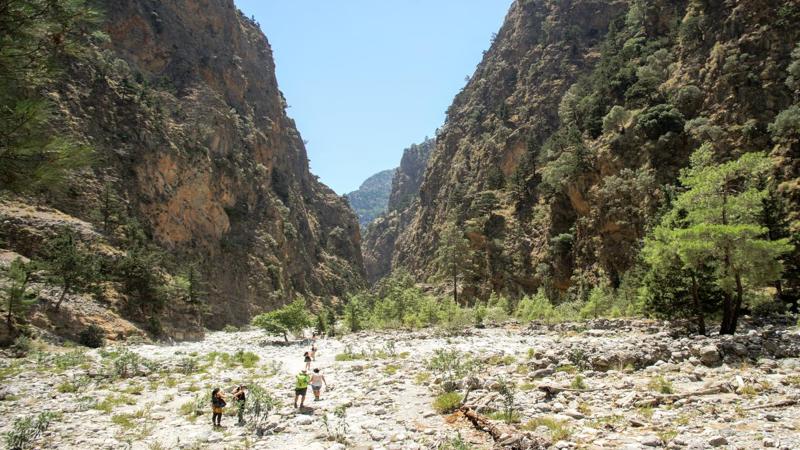

Plant Diversity
The gorge hosts over 450 plant species, including 70 endemics found only in Crete:
- Cretan Dittany (Origanum dictamnus) - Famous healing herb growing on inaccessible cliffs
- Cretan Maple (Acer sempervirens) - Ancient trees in the upper gorge
- Cypress (Cupressus sempervirens) - Some trees over 2,000 years old
- Cretan Ebony (Ebenus cretica) - Endemic with vibrant pink flowers
- Cretan Palm (Phoenix theophrasti) - Rare endemic palm in lower sections
- Rock Rose (Cistus creticus) - Aromatic shrub with pink flowers
- Wild Orchids - Several species bloom in spring
Seasonal Wildlife Variations
Wildlife viewing opportunities change throughout the year:
- Spring (May-June):
- Peak wildflower blooming
- Most active birdlife with nesting season
- Reptiles emerging from winter inactivity
- Young kri-kri may be visible with adults
- Summer (July-August):
- Reptiles most visible basking on rocks
- Reduced flower displays as heat increases
- Wildlife generally less active during daytime heat
- Best viewed early morning or late afternoon
- Autumn (September-October):
- Some autumn-flowering species emerge
- Migratory birds passing through
- More active wildlife as temperatures moderate
- Kri-kri more frequently sighted approaching rut season
Conservation Challenges
The Samaria ecosystem faces several conservation challenges:
- Balancing tourism impact with habitat preservation
- Climate change affecting water availability and species distribution
- Preventing introduction of non-native species
- Fire risk management in increasingly dry conditions
- Maintaining healthy population sizes of endangered species
Visitor cooperation is essential for conservation success. By staying on marked trails, not disturbing wildlife, removing all trash, and respecting park regulations, hikers contribute to preserving this unique biological treasure for future generations.
Historical & Cultural Significance
Beyond its natural splendor, Samaria Gorge holds deep historical and cultural significance that adds another dimension to the hiking experience. The gorge has been a witness to human history for thousands of years, from ancient civilizations to modern conflicts.
Ancient History
Archaeological evidence indicates human presence in the gorge dating back millennia:
- Minoan artifacts suggest religious significance as early as 3,000 BCE
- Ancient city of Tarra once existed near the gorge's southern exit
- Dorian influences visible in architectural remnants
- Ancient Greek inscriptions found in various locations
- Sacred caves used for worship of Apollo and Artemis
Byzantine Period
The gorge's religious significance continued during Byzantine times:
- Several Byzantine churches built within and near the gorge
- The church of Osia Maria (St. Mary of Egypt) in old Samaria village dates to the 14th century
- Hermit monks established cells in remote sections
- Religious pilgrimage routes passed through the gorge
- Byzantine trails and water management systems still visible in places
Venetian and Ottoman Periods
During Crete's occupation by foreign powers:
- Samaria village developed as a refuge from coastal raids
- Locals developed extensive knowledge of medicinal plants
- Ottoman authorities had limited control over the remote area
- Several resistance movements based operations in the gorge
- Traditional architecture adapted to local materials and climate
World War II
The gorge played a significant role during the Nazi occupation of Crete:
- Cretan resistance fighters used the gorge as a hideout
- Allied soldiers evacuated through the gorge to Egypt
- Secret supply drops occurred in remote areas
- Local villagers risked their lives to support resistance efforts
- Nazi forces rarely ventured deep into the gorge due to vulnerability to ambush
The Abandoned Village of Samaria
The centerpiece of human history in the gorge:
- Continuously inhabited from ancient times until 1962
- Population of approximately 400 people at its peak
- Self-sufficient community with olive groves, gardens, and livestock
- Residents relocated by government decree to establish the National Park
- Many former residents received compensation and houses in nearby villages
- Several buildings restored to demonstrate traditional architecture
- The village church remains consecrated with occasional services
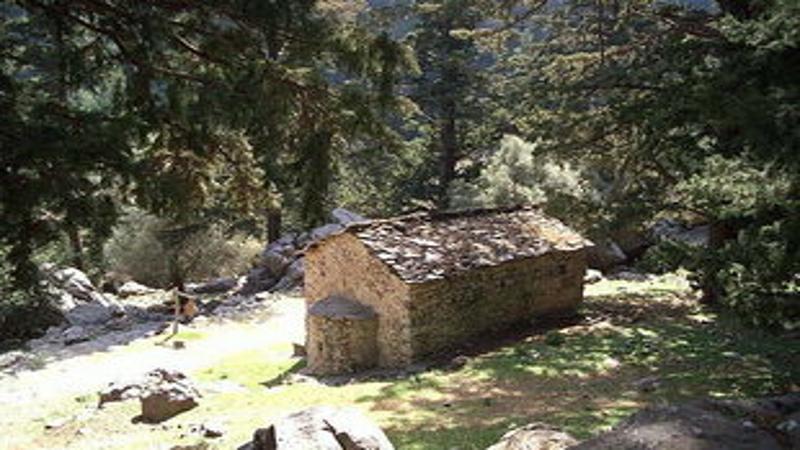
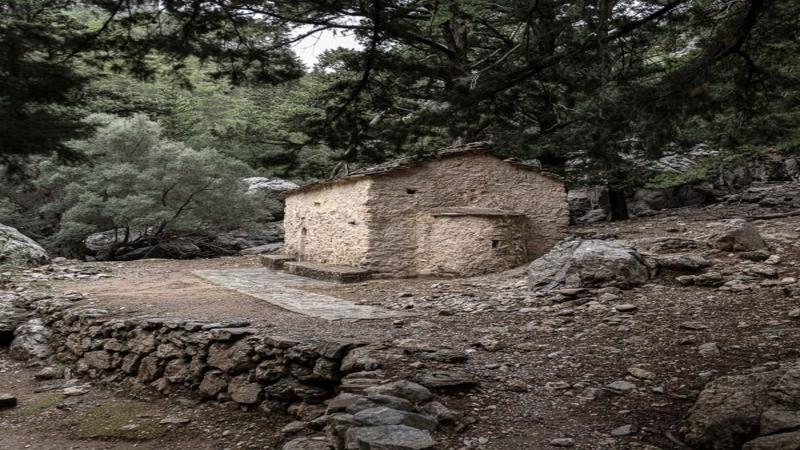
Traditional Life & Culture
The gorge represents a window into traditional Cretan mountain culture:
- Self-reliant lifestyle adapted to remote mountain conditions
- Traditional building techniques using local stone and timber
- Water management systems including channels and small dams
- Local knowledge of medicinal and edible plants
- Traditional shepherding routes cross the higher reaches
- Folk traditions and stories associated with specific locations
Modern Conservation History
The establishment of the National Park represents a milestone in Greek conservation:
- Created in 1962 as one of Greece's first national parks
- Designated a UNESCO Biosphere Reserve in 1981
- Pioneer model for balancing tourism and conservation
- Successful kri-kri recovery program prevented extinction
- Now serves as an outdoor classroom for environmental education
As you hike through Samaria, you're not just experiencing a natural wonder but also walking through layers of human history that have shaped both the gorge and broader Cretan identity.
Park Regulations & Conservation
As a National Park and UNESCO Biosphere Reserve, Samaria Gorge operates under specific regulations designed to protect its unique ecosystems while allowing visitors to experience its natural beauty.
Core Regulations
- Operating Hours: Entry permitted only from 6:00 AM to 4:00 PM (no entry after 2:00 PM)
- Overnight Stays: Not permitted within the park boundaries
- Entry Fee: €5 per person (reduced for students, free for children under 15)
- One-Way System: Visitors must proceed from north (Xyloskalo) to south (Agia Roumeli)
- Checkpoints: Several mandatory checkpoints where rangers record visitor passage
Environmental Protection Rules
To maintain the gorge's pristine condition, visitors must observe these important rules:
- Strict "Leave No Trace" Policy:
- All trash must be carried out (no bins within the gorge)
- No food scraps, fruit peels, or other organic matter to be left
- No toilet paper or hygiene products to be left in nature
- Wildlife Protection:
- No feeding, touching, or disturbing any animals
- Keep noise to a minimum to avoid disturbing wildlife
- Report but do not approach any injured animals to rangers
- Plant Conservation:
- No picking flowers, seeds, or plants of any kind
- No cutting or damaging trees or shrubs
- Stay on marked trails to prevent vegetation damage
- Water Protection:
- No washing in the river with soaps or detergents
- No adding any substances to water sources
- No blocking or diverting water flow
Activity Restrictions
The following activities are prohibited within the National Park:
- Camping or overnight stays
- Fires of any kind, including cooking stoves
- Hunting or fishing
- Collection of rocks, fossils, or artifacts
- Commercial photography without permit
- Use of drones without special authorization
- Swimming in the river (except at designated spots near Agia Roumeli)
- Entry with pets
- Smoking (fire risk)
Safety Regulations
For visitor safety and park management:
- All visitors must pass checkpoints by specific times
- Rangers may refuse entry to those improperly equipped
- Visitors must follow ranger instructions at all times
- The gorge may close without notice during dangerous conditions
- Groups must stay together and account for all members
Checkpoint System
The gorge operates several checkpoints to ensure visitor safety:
- Entry (Xyloskalo): Park fees collected, entry time recorded
- Intermediate Checkpoints: Several stations where rangers record passage
- Exit (Agia Roumeli): Tickets checked to ensure all visitors have exited safely
This system allows rangers to account for all visitors and identify anyone who might be missing or in need of assistance. Never bypass checkpoints or attempt to avoid rangers, as this can trigger unnecessary search operations.
Conservation Efforts
Your entrance fee supports important conservation work, including:
- Trail maintenance and safety improvements
- Scientific research on endemic species
- Habitat restoration projects
- Kri-kri monitoring and protection
- Fire prevention measures
- Educational programs
By respecting park regulations, you directly contribute to the preservation of this unique natural monument for future generations to enjoy.
Alternative Hikes & Options
While the full Samaria Gorge hike is the classic experience, several alternatives exist for those who prefer something shorter, less challenging, or when the main gorge is closed or inaccessible.
Shorter Samaria Options
For those who want to experience Samaria but aren't prepared for the full hike:
"Lazy Way" (Reverse Route)
- Take the morning ferry to Agia Roumeli
- Hike upriver into the gorge as far as desired (typically to the Iron Gates)
- Return the same way to Agia Roumeli for the afternoon ferry
- Distance: Flexible, typically 3-7 km each way
- Difficulty: Moderate, with gradual uphill on return
- Advantages: See the most dramatic part of the gorge, flexible distance, no transportation logistics
Top Section Only
- Start at Xyloskalo entrance
- Hike down into the gorge for 2-4 km
- Return the same way back up to Xyloskalo
- Distance: 4-8 km round trip
- Difficulty: Challenging due to steep uphill return
- Advantages: Experience the forest section and initial views, no need for boat transport
Alternative Gorges Near Samaria
Crete offers several other impressive gorges that provide excellent alternatives or companions to Samaria:
Imbros Gorge
- Location: 25 km east of Samaria
- Length: 8 km one-way
- Duration: 2-3 hours
- Highlights: Narrow passages, manageable length, accessible year-round
- Difficulty: Easy to moderate
- Logistics: Requires transportation arrangement at exit, or return taxi (€25-30)
Agia Irini Gorge
- Location: Western edge of White Mountains, near Sougia
- Length: 7.5 km one-way
- Duration: 3-4 hours
- Highlights: Less crowded, rich vegetation, ancient cypress trees
- Difficulty: Moderate
- Logistics: Ends at Sougia with boat connections to other coastal villages
Aradena Gorge
- Location: Near Loutro and Hora Sfakion
- Length: 7 km one-way
- Duration: 3-4 hours
- Highlights: Impressive bridge, vertical walls, wild landscape
- Difficulty: Moderate to challenging (involves some scrambling)
- Logistics: Can end at Marmara Beach with boat connection to Loutro or Hora Sfakion
Koutaliotiko Gorge
- Location: South of Spili, route to Preveli
- Length: 3 km one-way
- Duration: 1.5-2 hours
- Highlights: Dramatic sounds (named for the "clapping" of wind), flowing water year-round
- Difficulty: Moderate
- Logistics: Accessible by car at both ends
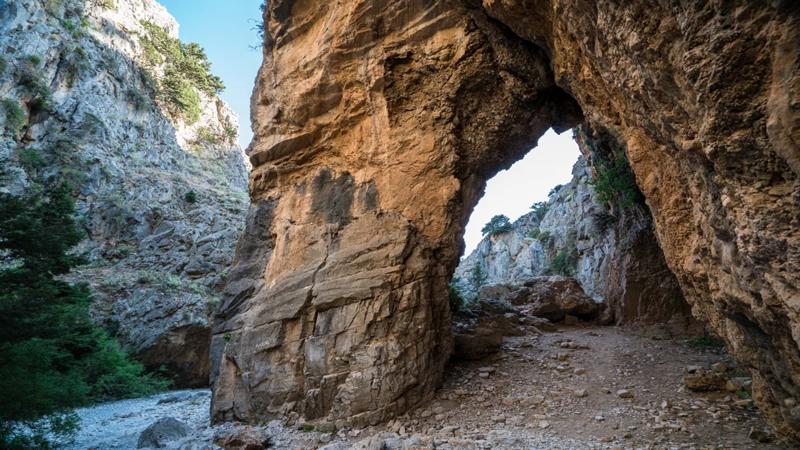
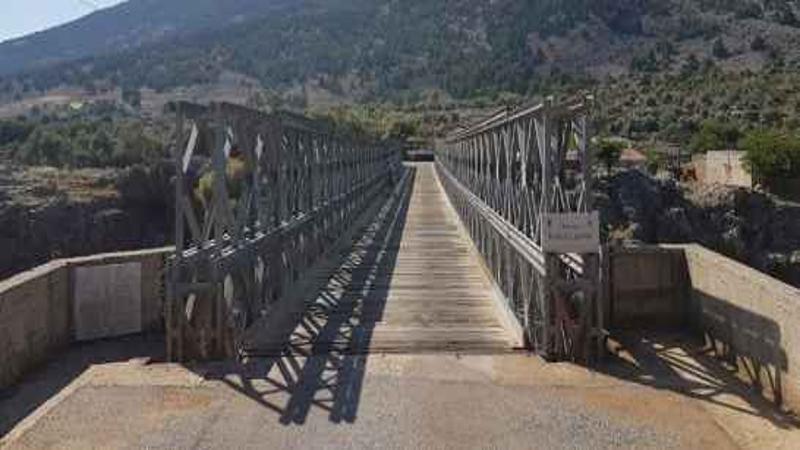
Combining Multiple Gorges
For enthusiastic hikers, several combinations work well:
- Samaria one day, Imbros the next (most popular combination)
- Agia Irini and Samaria on consecutive days
- Coastal trek from Loutro + Aradena Gorge as a two-day adventure
- "Three Gorges" mini-trekking holiday: Samaria, Imbros, and Agia Irini
These combinations offer a more comprehensive experience of Crete's diverse gorge landscapes, from the monumental scale of Samaria to the intimate narrows of Imbros.
Nearby Accommodation
Planning accommodation strategically can enhance your Samaria Gorge experience. Here are the best locations to stay before and after your hike, along with their advantages.
Pre-Hike Accommodation Options
Staying near the starting point allows for an early morning start without long pre-hike travel:
Omalos Plateau
- Location: Directly adjacent to the Xyloskalo trailhead
- Advantages:
- Closest accommodation to the gorge entrance (5-10 minute drive)
- Allows for earliest possible start time
- Beautiful mountain setting with cooler temperatures
- Quiet, peaceful environment
- Limitations:
- Limited accommodation options (2-3 small hotels and guesthouses)
- Few dining options
- Basic facilities only
- 4-season mountain climate (can be quite cold at night)
- Recommended for: Serious hikers prioritizing an early start
Chania
- Location: 43 km (1 hour drive) from trailhead
- Advantages:
- Wide range of accommodation options in all price ranges
- Vibrant old town with numerous restaurants and activities
- Convenient base for exploring western Crete
- Easy to arrange transport to Samaria (tour buses, public buses)
- Limitations:
- Early morning departure required (5:30-6:00 AM typically)
- Long day with significant travel time before and after hiking
- Recommended for: Most visitors, especially first-time Crete travelers
Post-Hike Accommodation Options
Staying near the exit point allows you to relax after the hike rather than facing additional travel:
Agia Roumeli
- Location: At the southern exit of the gorge
- Advantages:
- Immediate rest after completing the hike
- Opportunity to enjoy the beach and swim after hiking
- Peaceful village with no vehicle traffic
- Chance to experience sunset and evening at the quiet beach
- Several good tavernas serving fresh seafood
- Limitations:
- Limited accommodation options that book up quickly
- Few activities beyond beach and relaxation
- Essentially "trapped" until next day's ferry departure
- Recommended for: Those who want to fully relax after the hike and enjoy the remote village atmosphere
Hora Sfakion (Sfakia)
- Location: Ferry destination from Agia Roumeli
- Advantages:
- More accommodation and dining options than Agia Roumeli
- Authentic Cretan atmosphere
- Good base for exploring the Sfakia region
- Direct bus connections back to major towns
- Limitations:
- Requires ferry journey after hiking (1 hour)
- Still relatively remote
- Recommended for: Those wanting to explore more of southern Crete or break journey back
Sougia or Paleochora
- Location: Alternative ferry destinations from Agia Roumeli
- Advantages:
- Less touristic villages with beautiful beaches
- Good accommodation options at reasonable prices
- Access to additional hiking opportunities
- Limitations:
- Require ferry journey after hiking
- Less frequent bus connections to major towns
- Recommended for: Independent travelers looking to explore quieter parts of Crete
Booking Recommendations
- Reserve accommodations well in advance for peak season (June-September)
- Agia Roumeli's limited options book up earliest - 3+ months ahead recommended
- Omalos accommodations are also limited and should be booked early
- Most accommodations in the region require direct booking rather than through major platforms
- Look for cancellation flexibility in case the gorge closes due to weather
Safety Information
While Samaria Gorge is well-maintained and patrolled by park rangers, its remote nature and challenging terrain require visitors to take safety seriously. Here's what you need to know to ensure a safe hiking experience.
Primary Safety Concerns
- Heat Exhaustion/Dehydration: Summer temperatures can exceed 35°C (95°F), especially in the lower gorge
- Physical Exhaustion: The 16km distance and challenging terrain can cause severe fatigue
- Falls/Ankle Injuries: Uneven, rocky terrain presents trip and fall hazards
- Flash Floods: Rare but dangerous during and after heavy rainfall
- Limited Emergency Access: Medical evacuation is complicated by the remote location
Heat Safety
Heat-related illness is the most common safety issue in Samaria, particularly during summer:
- Carry and drink plenty of water (minimum 2 liters per person)
- Use electrolyte supplements in very hot conditions
- Wear a wide-brimmed hat and use sun protection
- Rest in shaded areas regularly
- Recognize early signs of heat stress: headache, dizziness, excessive sweating or lack of sweating, nausea
- Start early to complete the most exposed sections before midday heat
Terrain Safety
To navigate the challenging terrain safely:
- Wear proper hiking footwear with ankle support and good traction
- Use trekking poles to improve stability, especially on descent
- Watch your footing constantly - avoid looking at scenery while walking
- Take extra care at river crossings where rocks may be slippery
- Proceed carefully on loose gravel sections
- Maintain a sustainable pace rather than rushing
Weather Safety
Weather conditions can change rapidly in the mountains:
- Check weather forecasts before starting your hike
- Be aware that rain in the mountains can cause flooding hours later in the gorge
- Follow ranger instructions regarding potential closures
- Carry a light rain jacket even on clear days
- Never enter the gorge during heavy rain or if flash flood warnings are issued
- Seek high ground immediately if water levels rise suddenly
Emergency Procedures
In case of emergency:
- Contact a park ranger at one of the manned stations throughout the gorge
- If unable to reach a station, send someone to find help while others stay with any injured person
- Rangers have radio communication with emergency services
- For serious emergencies, helicopter evacuation is possible from certain clearings
- Basic first aid is available at the main ranger station in old Samaria village
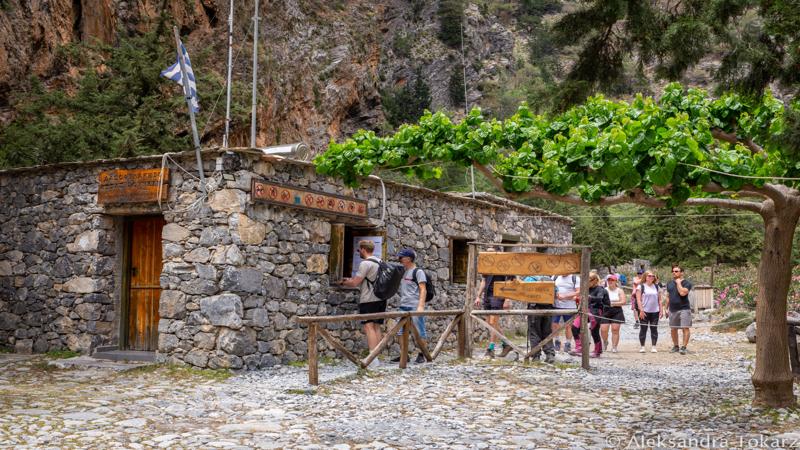

Medical Considerations
Before attempting the hike, be aware of these medical factors:
- The hike is not recommended for people with:
- Serious heart conditions
- Severe joint problems, especially knees
- Balance or mobility issues
- Uncontrolled diabetes or similar conditions requiring regular medication/food
- Consult a doctor before hiking if you have any medical concerns
- Carry any necessary personal medications in adequate supply
- Inform hiking companions of any medical conditions
Child Safety
If hiking with children:
- Generally suitable only for children 8+ years who are experienced walkers
- Children should remain within sight of adults at all times
- Enforce regular water and rest breaks
- Be particularly vigilant about sun protection for children
- Pack extra snacks and engaging activities for motivation
- Be prepared to turn back if a child shows signs of excessive fatigue
By respecting the guidelines above and approaching the hike with proper preparation, you'll maximize both safety and enjoyment of this remarkable natural wonder.
Frequently Asked Questions About Samaria Gorge
The difficulty of Samaria Gorge is often misunderstood. It's not technically challenging in terms of climbing or exposure to heights, but it presents endurance challenges for three main reasons: length (16km), terrain (rocky and uneven throughout), and conditions (potential heat, especially in summer). The constant downhill for the first half can be tough on knees and ankles, while the distance causes fatigue for many hikers. While thousands of people of varying fitness levels complete it annually, it's not a casual walk. Most reasonably fit individuals who regularly walk 5+ km can manage it by pacing themselves and taking regular breaks. The key factors determining your experience will be: proper footwear, physical preparation, pacing, and weather conditions. Someone in good condition with proper footwear might find it moderately challenging, while someone with joint issues or inappropriate shoes might find it very difficult. Allow 5-7 hours and don't underestimate the preparation needed.
Yes, it's entirely possible to hike Samaria Gorge independently, and many visitors prefer this option for the added flexibility. To do so, you'll need to arrange your own transportation to the trailhead at Xyloskalo (Omalos) and plan for the return journey from Agia Roumeli. The most common independent approach is: 1) Take the public KTEL bus from Chania to Omalos (departs around 7:00 AM daily during season), 2) Hike the gorge at your own pace, 3) Take the ferry from Agia Roumeli to Hora Sfakion (typically departing at 5:30 PM), 4) Catch the connecting KTEL bus from Hora Sfakion back to Chania. All tickets can be purchased individually on the day, though booking the morning bus a day ahead is recommended in peak season. This independent approach costs approximately the same as an organized tour (€35-40 total for all transportation plus the €5 entrance fee) but offers more flexibility with your timing, particularly for how long you spend in the gorge and at Agia Roumeli beach afterward.
During peak season (July-August), Samaria Gorge receives between 1,000-3,000 visitors daily, making it undeniably crowded at certain points. However, the experience varies significantly depending on your timing and pace. The most congested periods occur at the entrance between 8:00-10:00 AM when most organized tours arrive, at popular rest spots around midday, and at the Iron Gates (the narrowest section) from late morning through afternoon. The trail's length naturally distributes hikers, so you'll often find yourself alone or with just a few others nearby if you maintain a pace different from the main groups. For a less crowded experience: 1) Start very early (6:00-7:00 AM) or slightly later (after 10:00 AM) than the tour groups, 2) Hike in May, early June, or September when visitor numbers drop by 40-60%, 3) Consider weekdays rather than weekends, 4) Maintain a slightly faster or slower pace than average to create distance from the largest groups. Even during peak season, the gorge's beauty and scale make it worth visiting – just adjust your expectations and timing accordingly.
Missing the last ferry from Agia Roumeli (which typically departs around 5:30 PM during high season) would leave you with no choice but to stay overnight in the village, as there are no roads connecting it to other areas. If this happens, immediately look for accommodation, as options are limited and may fill quickly with others in the same situation. Agia Roumeli has approximately 10-15 small hotels and guesthouses, ranging from budget rooms to more comfortable options. In absolute peak season, all accommodations could potentially be full, though most establishments will try to help find solutions if possible. Always carry a credit card and extra cash for such emergencies. To avoid this situation: 1) Begin your hike early enough (no later than 10:00 AM) to ensure completion with ample time buffer, 2) Check the ferry schedule which can vary seasonally and by destination, 3) Consider booking a cancellable room in advance if you're concerned about hiking speed, 4) Know the last ferry departure time before you begin hiking and set an alarm for your absolute latest departure time from key points in the gorge.
Samaria Gorge is officially closed from November 1st to April 30th each year, though these dates can shift slightly depending on weather conditions and maintenance needs. The opening and closing dates are not entirely predictable as they depend on several factors: 1) Weather conditions - heavy rains or storms near the usual opening date may delay access for safety reasons, 2) Trail maintenance status - repairs to paths, bridges, and facilities must be completed before opening, 3) Staffing and operational readiness of the National Park. Early closures during the operating season can occur with little warning in case of dangerous weather conditions, particularly flash flood risks after heavy rainfall in the mountains. For the most reliable information: check the official Samaria National Park website a few weeks before your planned visit, contact the Forestry Department in Chania (responsible for the park) for the latest status, or ask your accommodation provider who typically has current information. If you're visiting during early May or late October, having a backup plan is advisable as opening/closing dates may shift by a week or more from year to year.
Yes, there are restroom facilities at strategic points along the Samaria Gorge trail, though their number and condition are basic given the remote setting. You'll find toilets at: 1) The entrance (Xyloskalo) - usually the cleanest and best maintained, 2) First water stop (approximately 2km into the hike), 3) Abandoned Samaria village (halfway point) - multiple facilities here as it's the main rest area, 4) Near the exit of the National Park (before the walk to Agia Roumeli), 5) Agia Roumeli village (multiple options). These facilities are typically basic pit or composting toilets with variable maintenance, especially during peak season with high visitor numbers. Toilet paper is sometimes available but not guaranteed, so carrying a small personal supply is recommended. Between these established facilities, if nature calls, you must follow strict leave-no-trace principles: move at least 50 meters away from the trail and any water sources, carry out all toilet paper and hygiene products (bring small sealable bags for this purpose), and bury any solid waste in a small hole (15cm deep) that you dig and cover afterward. The National Park has strict regulations against improper waste disposal to protect the water quality and natural environment.
The likelihood of spotting kri-kri (Cretan wild goats) during your Samaria Gorge hike varies significantly based on several factors. During peak season (July-August) with high visitor numbers, sightings are less common as the animals tend to retreat to quieter, higher areas. However, your chances improve considerably during: 1) Early morning or late afternoon when human traffic is reduced, 2) Shoulder seasons (May-June and September-October) with fewer hikers, 3) Sections of the gorge away from main rest areas. Most sightings occur as brief glimpses of the goats on the high cliff faces where they navigate with remarkable agility, so scanning the upper slopes regularly improves your chances. Binoculars are highly recommended for wildlife enthusiasts. The kri-kri population in Samaria (estimated at 2,000-3,000) has recovered well under protection, so while not guaranteed, there's a reasonable 30-50% chance of a sighting during a full gorge hike if you remain observant - though this might be just a distant view. For closer observations, the area around the old village of Samaria occasionally has semi-habituated individuals, but feeding is strictly prohibited as it harms their natural behaviors and health.
If someone in your group cannot complete the Samaria Gorge hike after starting, the options are limited due to the one-way nature of the trail and lack of vehicle access. Here are the available solutions: 1) Turn back to the entrance (practical only if the issue occurs early in the hike, within the first 2-3km), 2) Continue at a slower pace with more frequent rest stops (viable if the person can still walk but is experiencing fatigue), 3) Seek ranger assistance at one of the stationed checkpoints (rangers can provide basic first aid and advice), 4) In serious cases, emergency evacuation can be arranged, though this is complex and typically reserved for medical emergencies rather than exhaustion. For evacuation, options include: stretcher transport by a ranger team to the nearest accessible point, mule transport in certain sections (not always available), or helicopter evacuation for critical medical situations. To avoid these difficult scenarios: be realistic about everyone's fitness levels before attempting the gorge, start early to allow for a very slow pace if needed, consider the "Lazy Way" (partial hike from Agia Roumeli upward then back) for groups with mixed abilities, and ensure everyone has proper footwear and sufficient water. Park staff will always assist visitors in difficulty, but preparation and honest assessment of abilities remain the best approach.
Why Rent a Car for Your Samaria Gorge Visit
While organized tours and public buses provide access to Samaria Gorge, having your own rental car offers significant advantages for experiencing this natural wonder and exploring the surrounding region:
- Flexibility to arrive at Xyloskalo entrance early, beating the crowds and the heat
- Freedom to set your own schedule without dependence on fixed tour departure times
- Ability to combine your Samaria hike with visits to nearby attractions at your own pace
- Option to stay in more remote accommodations near the trailhead for early access
- Easy transport of extra clothing, proper hiking equipment, and supplies
- Comfort of air conditioning after a long, hot hike when returning from Hora Sfakion
- Opportunity to explore other gorges and natural wonders in western Crete
- Convenience for family groups or friends hiking at different paces
- Access to less-visited entry points for alternative hiking routes
- Flexibility to change plans if weather conditions affect gorge accessibility
At Fast and Easy Rent a Car Crete, we offer:
- Unlimited mileage on all rentals
- No security deposit required
- Free additional driver
- 24/7 roadside assistance
- Comprehensive insurance options
- New, well-maintained vehicles
- Free cancellation up to 48 hours before pickup
Explore More of Western Crete
Samaria Gorge is just one highlight in our comprehensive 8-day Crete itinerary. Discover more stunning gorges, mountain villages, and authentic experiences with our detailed self-drive tour plan.
View Our Complete Crete ItineraryNeed Assistance Planning Your Samaria Gorge Visit?
Our local team knows Crete inside out and can help you plan the perfect itinerary that includes Samaria Gorge and other nearby attractions. Contact us for personalized recommendations and special car rental offers.
